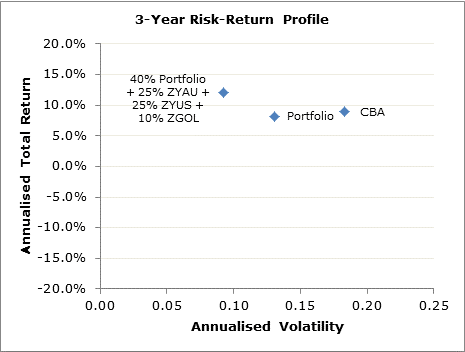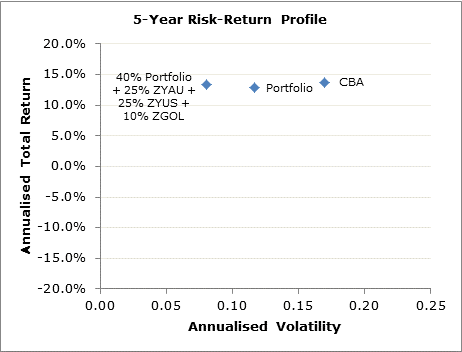Investment in stocks is the mainstay of Australian portfolios. Why wouldn’t it be? Australia is one of the most developed economies in the world. Companies are generally in good health and there are franking credits, one of the greatest gifts to investment returns a government can give to their populace.
However, the reality is that it’s risky to only invest in Australian stocks. Why is that the case?
One of the fundamental lessons in finance is that investing in single stocks leaves you open to all of the ups and downs of that particular company, with no built-in method to reduce the impact of losses except for selling the position.
Stocks that move aggressively up and down in price are the life blood of the trading community but are the downfall of the investment equivalent. This is because, generally, stocks do rise over long periods but when the falls come they’re normally much more violent than the slower earned gains. There are also many companies that simply fail – and that’s a 100% loss on that investment. This can seriously affect a portfolio’s worth if you’re unlucky on timing.
Most Australians know this either because they have read about it, or more likely because they have been burned before when taking too much risk by holding just a few stocks. So they take the step of trying to “diversify” their portfolio. This is the well-touted mechanism of buying several stocks to build a broader portfolio with the view that where one stock may dramatically fall, others will be less affected or not affected at all, outweighing the loss. However, in almost all cases, the attempt to diversify will see an investor holding approximately ten stocks or fewer. In truth, if you’re holding less than thirty, you’re not diversified.
Investing in stocks isn’t a bad thing. Indeed there are hardly any other asset classes that offer a better opportunity to grow wealth significantly over the long term. However, what goes up quickly can also come down, sometimes very quickly indeed.
So is there a better way? Is there a world where investors can continue to invest in companies that they feel strongly about, whilst also having a better balanced core portfolio – which is the main driver of returns and crucially protects it on the downside? Yes there is.
Exchange traded funds (ETFs) offer a good solution. ETFs are funds that you can buy and sell on exchange exactly like stocks. They are nearly always well diversified, tracking a specific index. For example an ETF tracking the ASX 100 will generally hold all the companies within the ASX 100 in the weights given by the index provider (in this case S&P Dow Jones Indices and the ASX). Their trading mirrors at the value of the stocks within the fund (no premiums or discounts) and are have management fees lower than actively managed funds. They are well designed for most Australian investor portfolios for these reasons and, as will become apparent, using them alongside your stock positions can be one of the cheapest and easiest ways to significantly reduce the risk in a portfolio currently focused just on a few stocks.
By constructing a portfolio of 50% to 80% ETFs, with the remaining balance used for single stock investment, an investor gets the best of both worlds. Let’s explore this in more detail.
Portfolio Simulation
Let’s take three portfolios as below:-
Portfolio 1 (CBA):- Commonwealth Bank shares
Portfolio 2 (Portfolio):
An equally weighted portfolio of:-
• CBA
• WOW
• BHP
• TLS
• CSL
Portfolio 3:
• Portfolio 2 above (now 40%)
• ZYAU – an ANZ ETFS ETF tracking the highest paying stocks in Australia (25%)
• ZYUS – an ANZ ETFS ETF tracking the highest paying stocks in America (25%)
• ZGOL – ANZ ETFS’ Physical Gold ETF (10%)
Looking at these portfolios in action below there are a few lessons:
• A single stock (e.g. CBA) may be risky on its own. Over three years it returned just over 8% per annum, which is excellent, but lost 15% in the most recent year
• Portfolio 3 has a 65% Australian allocation with 40% via direct stocks and 25% via a fund. This neatly accomplishes the desire to invest directly in Australian stocks but also includes a diversified Australian dividend fund which, by including forty high yielding Australian stocks, and therefore exceeding the commonly accepted number of securities to meet the principle of diversification (thirty or more), reduces overallrisk
• Additionally it now includes ETFs tracking the US and gold. Their inclusion has now reduced risk to the Australian market and has provided access to international and commodity exposure, both of which will further help reduce overall portfolio risk.
.gif)


Notes
Source: Bloomberg, ANZ ETFS. Data as of 31 Mar 2016.
Australia Government Bond 3-Month as risk-free rate.
Portfolios are monthly rebalanced.
For ZYAU, ZYUS and ZGOL, performances prior to fund launch i.e. 9 Jun 2015 were proxy by underlying benchmark return – management fee of the respective fund.
Past performance is no indicator of future performance
Redesigning your portfolio in this way may seem difficult, but the potential reduced levels of risk may be worth it.
Additionally, what the portfolio simulation doesn’t show is the transactional cost advantage to your portfolio management. Simply put, to buy Portfolio 3 requires only eight sets of trade commissions but you now own the equivalent of nearly 100 stocks diversified by geographic exposure, sector and asset class.
Stocks will always be the mainstay for Australian investors but, as illustrated, by combining these with ETFs you’ll gain a quick and easy way to design portfolios like these which may reduce the risk in your overall portfolio.
What’s more, it’s as simple as buying the stocks you’re already comfortable buying. Stocks or ETFs? You don’t have to choose. Take the best of both.







